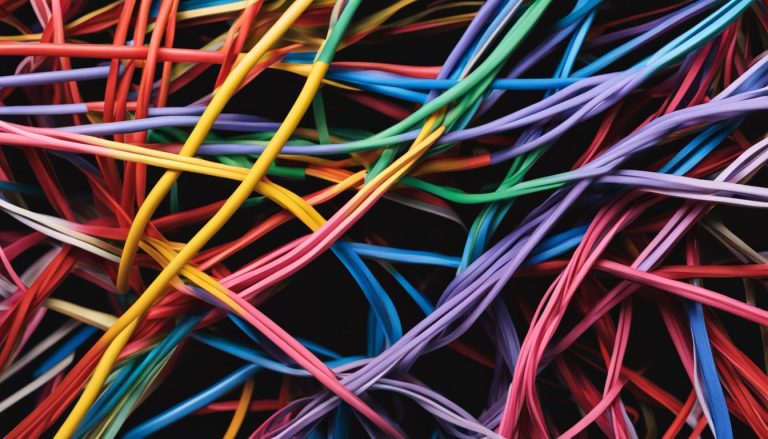User experience (UX) design is the process of creating products or systems that provide the best possible experience for users. It involves understanding user needs, conducting research, and designing interfaces that are both visually appealing and easy to use. A successful UX design ensures that users can navigate a website or application effortlessly, find the information they need, and accomplish their goals efficiently.
UX design is not just about aesthetics; it goes beyond a product’s appearance. It focuses on factors such as the look, feel, and usability of a product, aiming to create a bond of trust and credibility between the user and the product. By addressing user problems and developing products that are a joy to use, UX designers strive to enhance the overall user experience.
Key Takeaways:
- User experience (UX) design aims to create products that offer the best possible experience for users.
- UX design involves understanding user needs, conducting research, and designing visually appealing and user-friendly interfaces.
- The importance of UX design lies in enhancing the overall user experience, building trust and credibility.
- UX designers address user problems and develop products that are a joy to use.
- A successful UX design ensures easy navigation, findability, and efficient goal accomplishment for users.
The Role of UX Design in Creating User-Centric Products
User-centered design is at the core of UX design. UX designers focus on understanding the needs and goals of users and creating products that fulfill those needs. By employing principles and best practices, they ensure that the user’s experience with the product is meaningful and valuable.
UX designers incorporate elements from various disciplines to optimize the user experience. They combine project management, user research, usability evaluation, information architecture, user interface design, interaction design, visual design, content strategy, and web analytics to create products that are tailored to the user.
The key principles of UX design include:
- Usability: Designing interfaces that are intuitive and easy to navigate
- Desirability: Creating products that evoke positive emotions and satisfaction
- Findability: Ensuring that users can easily locate information or features they need
- Accessibility: Making the product usable by users with different abilities
- Credibility: Establishing trustworthiness and reliability with the user
By considering these principles, UX designers create user-centric products that not only meet the user’s needs but also provide a seamless and enjoyable experience.
| UX Design Principles | Examples |
|---|---|
| Usability | Intuitive navigation, clear call-to-action buttons |
| Desirability | Engaging visuals, appealing color schemes |
| Findability | Efficient search functionality, well-organized content |
| Accessibility | Alternative text for images, keyboard navigation |
| Credibility | Clear privacy policy, customer reviews and testimonials |
“Good design is making something intelligible and memorable. Great design is making something memorable and meaningful.” – Dieter Rams
User-Centered Design: Putting the User First
User-centered design is the foundation of UX design. It emphasizes the importance of understanding and empathizing with the user’s needs, goals, and motivations. By prioritizing the user throughout the design process, UX designers can create products that truly resonate with their target audience.
UX design best practices involve conducting user research to gain insights into user behavior and preferences. This research helps identify pain points, uncover user expectations, and guide the design decisions. Prototyping and testing are integral parts of the process, allowing designers to gather feedback, iterate, and refine their designs based on user insights.
Ultimately, the role of UX design is to ensure that the user’s experience with a product is not only visually appealing but also effortless, enjoyable, and meaningful. By placing the user at the center of the design process, UX designers can create products that meet real user needs and deliver exceptional experiences.
The Difference Between Graphic Design and UX Design
Graphic design and UX design may share some similarities, but they have distinct differences in their goals, approaches, and focus. While both disciplines involve creativity and aesthetics, graphic design primarily focuses on emotional communication through typography, color, and images, aiming to elicit specific reactions in the user. On the other hand, UX design takes a broader view of the user’s experience with the product, encompassing factors such as motion design, tone of content, and information architecture.
In graphic design, the emphasis is on creating visually appealing and aesthetically pleasing designs. Graphic designers use their creative thinking skills to craft compelling visuals that captivate the audience’s attention and convey a specific message or brand identity. They often work on projects such as branding, marketing materials, and print design.
On the other hand, UX design focuses on creating user-centric products by understanding user needs, conducting research, and designing interfaces that are easy to use and navigate. UX designers employ creative thinking to solve user problems and employ prototyping techniques to test and improve their designs. They prioritize user satisfaction and aim to create products that provide a seamless and enjoyable experience.
“Graphic design focuses on emotional communication through typography, color, and images, while UX design takes a broader view of the user’s experience with the product.”
While graphic design skills can be useful in UX design, transitioning from graphic design to UX design requires a shift in mindset and the acquisition of additional skills. Graphic designers can leverage their expertise in aesthetics and conventions to quickly adapt to UX design. Their understanding of visual communication and design principles can help them create visually appealing interfaces, while their creative thinking skills enable them to come up with innovative solutions to enhance the overall user experience.
In conclusion, while graphic design and UX design are distinct disciplines, they both contribute to creating engaging and user-centric products. Graphic designers looking to switch to UX design can leverage their skills in aesthetics, conventions, and creative thinking to thrive in this exciting field.
Graphic Design vs. UX Design: A Comparison
To provide a clearer picture of the differences between graphic design and UX design, let’s summarize the key contrasts:
| Graphic Design | UX Design |
|---|---|
| Emotional communication through typography, color, and images | Focus on the overall user experience and interaction with the product |
| Aesthetically pleasing designs for branding and marketing materials | User-centric approach with an emphasis on usability and functionality |
| Creative thinking to convey a specific message or brand identity | Creative problem-solving to address user needs and enhance the user experience |
Note: The image visually represents the contrast between graphic design and UX design.
The Benefits of Graphic Design Experience in UX Design
Graphic designers bring valuable skills to UX design, particularly in creating attractive and aesthetically pleasing interfaces. Good aesthetics have been found to enhance the overall user experience, making users more relaxed and creating a positive first impression.
Graphic designers can leverage their knowledge of design terminology, conventions, and trends to adapt quickly to UX design. Their experience in graphic design allows them to understand the importance of aesthetics in creating a visually appealing and engaging user interface. By incorporating their skills in color theory, typography, and composition, graphic designers can create interfaces that are both visually appealing and functional.
Furthermore, graphic designers’ ability to communicate research findings effectively through well-presented visuals can be advantageous in stakeholder engagement. By using visual storytelling techniques, they can convey complex information in a concise and engaging manner, making it easier for stakeholders to understand the design decisions and the impact on the user experience.
In conclusion, the experience of graphic designers in aesthetics, conventions, and trends can be a valuable asset in the field of UX design. Their ability to create visually appealing interfaces and effectively communicate design decisions sets them apart in the user-centric design process. By leveraging their graphic design skills and adapting to the UX design principles and methodologies, graphic designers can contribute to creating exceptional user experiences.
The Elements That Influence User Experience
User experience (UX) is heavily influenced by various factors that contribute to the overall value users find in a product. Understanding these elements is crucial for UX designers in creating interfaces that deliver optimal user experiences. Let’s explore the key factors that influence UX:
Usefulness
The usefulness of a product is vital in determining its value to users. It’s essential to design products that effectively address user needs and solve their problems. UX designers should focus on understanding the target audience and their pain points to create features that provide practical solutions. By ensuring the product’s usefulness, designers can enhance the overall satisfaction of the user experience.
Usability
Usability plays a significant role in user experience. Products that are easy to use, navigate, and understand naturally lead to better user satisfaction. UX designers must prioritize the simplicity and intuitiveness of the interface to minimize user effort and frustration. Conducting user testing and gathering feedback can help identify areas for improvement and optimize the usability of the product.
Desirability
The desirability of a product influences the emotional connection users have with it. Visual aesthetics, branding, and overall design are crucial in creating an appealing and desirable user experience. By crafting visually engaging interfaces and incorporating elements of emotional design, UX designers can evoke positive emotions and enhance user satisfaction and engagement.
Findability
Findability refers to how easily users can locate and access the content or features they need within a product. UX designers should prioritize organizing and structuring content in a logical manner, implementing clear navigation systems, and providing search functionalities to improve findability. Enhancing findability ensures that users can quickly and efficiently accomplish their goals, leading to a positive user experience.
Accessibility
Creating an inclusive user experience is essential in today’s diverse digital landscape. Accessibility focuses on designing products that can be accessed and used by all individuals, regardless of their abilities or disabilities. UX designers should adhere to accessibility guidelines and standards, ensuring that the product is perceivable, operable, understandable, and robust for all users.
Credibility
Establishing trust and credibility is crucial in ensuring a positive user experience. Users need to feel confident in the reliability and authenticity of the product. UX designers should incorporate elements such as clear and transparent communication, trustworthy visual design, and secure interactions to build user trust. A credible product enhances user satisfaction and encourages continued engagement.
By considering these elements throughout the UX design process, designers can create products that deliver exceptional user experiences. Understanding the factors that influence UX enables designers to tailor their designs to meet user expectations, resulting in products that are valuable, enjoyable, and impactful.
| Factors that Influence UX | Description |
|---|---|
| Usefulness | Addresses user needs and solves problems |
| Usability | Easy to use, navigate, and understand |
| Desirability | Appealing and emotionally engaging design |
| Findability | Content and features are easy to locate and access |
| Accessibility | Inclusive design for all users |
| Credibility | Establishes trust and reliability |
Conclusion
User Experience (UX) design is a critical aspect of creating user-centric products that prioritize user satisfaction. As a UX designer, I understand the importance of conducting thorough research and gaining a deep understanding of user needs. By employing design principles and best practices, I can create visually appealing and user-friendly interfaces that cater to specific user requirements.
For graphic designers looking to transition into UX design, your skills in aesthetics, conventions, and creative thinking are highly valuable. Leveraging your knowledge in these areas can help you quickly adapt to the field and contribute to the overall user experience.
The significance of UX design in enhancing the overall user experience cannot be overstated. Through the careful consideration of factors such as usefulness, usability, desirability, findability, accessibility, and credibility, UX designers strive to deliver products that are both functional and enjoyable to use. In the ever-evolving digital world, UX design remains an impactful and rewarding field, full of opportunities to make a positive impact on users’ lives.
FAQ
What is User Experience (UX) Design?
User Experience (UX) Design is the process of creating products or systems that provide the best possible experience for users. It involves understanding user needs, conducting research, and designing interfaces that are both visually appealing and easy to use.
Why is User Experience (UX) Design important?
User Experience (UX) Design is important because it focuses on factors such as usability, desirability, findability, accessibility, and credibility. By addressing user problems and developing products that are a joy to use, UX designers strive to enhance the overall user experience.
How does User Experience (UX) Design differ from Graphic Design?
User Experience (UX) Design takes a broader view of the user’s experience with the product, encompassing aspects such as motion design, tone of content, and information architecture. Graphic Design focuses on emotional communication through typography, color, and images.
Can Graphic Designers transition to UX Design?
Yes, Graphic Designers can leverage their skills in aesthetics, conventions, and creative thinking to adapt quickly to UX Design. Their experience in graphic design can be a valuable asset in the field of UX Design.
What factors influence User Experience?
User Experience is influenced by various factors, including usefulness, usability, desirability, findability, accessibility, and credibility. These factors contribute to the overall value users find in a product.
Janina is a senior specialist in information technology


